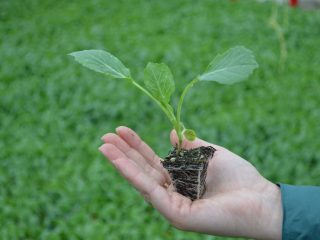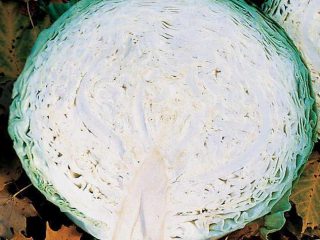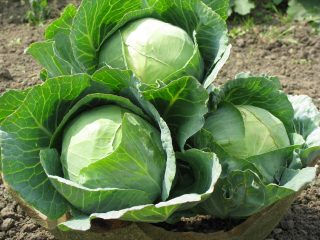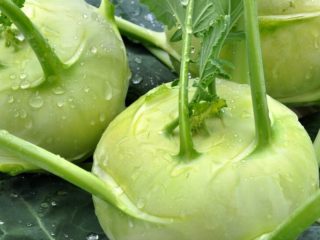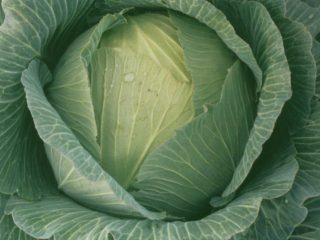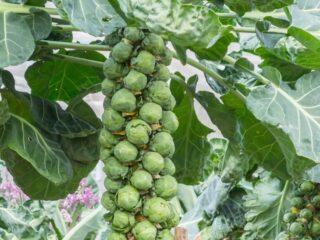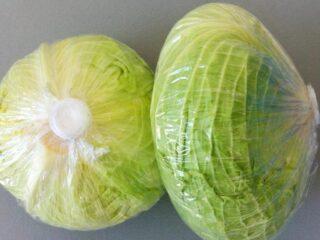Content
- 1 Choosing a variety for planting
- 2 Early varieties of Brussels sprouts
- 3 Mid-season cabbage varieties
- 4 Late ripening varieties of Brussels sprouts
- 5 The best varieties of Brussels sprouts for the Moscow region
- 6 Brussels sprouts varieties for Siberia
- 7 Brussels sprouts varieties for the Urals
- 8 Conclusion
Until recently, Brussels sprouts did not “take root” in Russia. This is due to the length of the active growing season. However, thanks to the efforts of domestic and foreign breeders, hybrids and varieties of Brussels sprouts with “shortened” ripening appeared. But this is not the only criterion that you need to focus on when choosing the most suitable option for yourself - you need to study all the characteristics.
Choosing a variety for planting
Many agree that the best option for Russia will be the seeds of Brussels sprout hybrids, rather than varieties. Moreover, both domestic and foreign (mostly Dutch). They differ:
- Consistently high seed quality;
- good yield;
- “mass” maturation, external presentability and one-dimensionality;
- general endurance, including the ability to withstand the negative influence of external factors and resist pests.
However, due to the peculiarities of the Russian climate, which is not favorable for gardening in all regions, the first thing you need to pay attention to when choosing a variety or hybrid of Brussels sprouts is the period of its ripening. Otherwise, you may not get a harvest at all; all the gardener’s efforts will be in vain.
Early varieties of Brussels sprouts
Early ripening dates vary between 85-120 days. Moreover, in different regions, “deviations” from the duration of the growing season indicated by the originator in the description are acceptable.
Dolmik F1
Dolmik F1 is a hybrid of Brussels sprouts created in the Netherlands by the fairly well-known agricultural company Royal Sluis. It has been in the State Register of Breeding Achievements of the Russian Federation since 1994, officially recognized as suitable for planting in all regions, suitable for cultivation in “street” beds and in greenhouses. The harvest ripens in 90-105 days.
The plants are tall (about 70 cm), but not spreading, and relatively compact. The heads of cabbage form an even cylinder on the stem. A regular, almost spherical shape is typical for them, weight varies between 7-17 g. If the planting scheme is followed, in general the result is 1.5-2.5 kg/m².
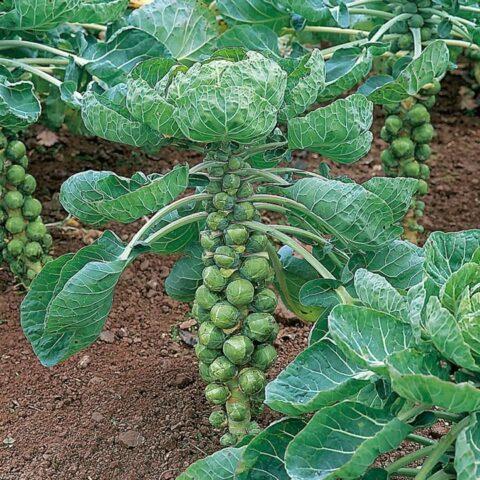
Dolmik F1 is officially listed in the State Register as a salad hybrid, but is also well suited for freezing
Franklin F1
Franklin F1 is a hybrid from the world famous company Bejo Zaden B.V. It entered the State Register of the Russian Federation in 2007. Recognized as suitable for planting in all regions, universal, based on its potential for use in cooking.
The leaf rosettes of the Franklin F1 hybrid are tall (75-80 cm) and spreading.Plants tolerate short-term sharp drops in temperature and temperature changes well.
The ripening period of the crop varies from ultra-early to early (85-100 days). Approximately 70 dense heads of cabbage weighing slightly more than 1 kg ripen on the stems. Amateur gardeners remove 2.8 kg from 1 m². The taste is officially described as "excellent".
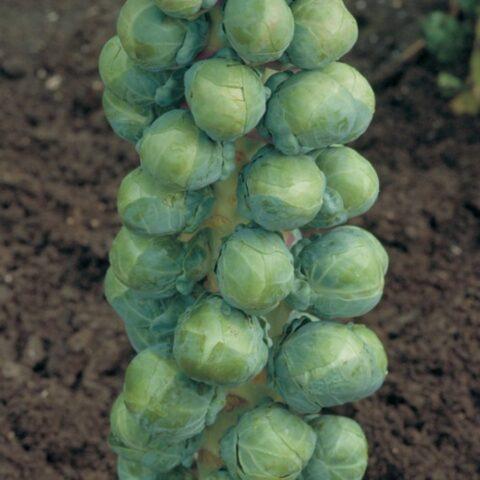
Breeders provided the Franklin F1 hybrid with “innate” immunity to fusarium
Diablo F1
Diablo F1 is another achievement of Dutch breeders (Bejo Zaden B.V.). It has been listed in the Russian State Register since 2006. It is officially recognized as suitable for cultivation throughout the Russian Federation.
According to the ripening period - early or mid-early (95-110 days). The stems are below average in height, the rosettes are relatively compact. Plants are distinguished by good cold resistance and resistance to pathogenic microflora and insects.
The heads of cabbage are extremely dense, one-dimensional, large (15-18 g), almost spherical. 40-55 pieces are formed on each stem, the yield is 0.9-1 kg. From 1 m² you get 2.1-3.9 kg. The taste deserves an “excellent” rating; there is not the slightest hint of bitterness.
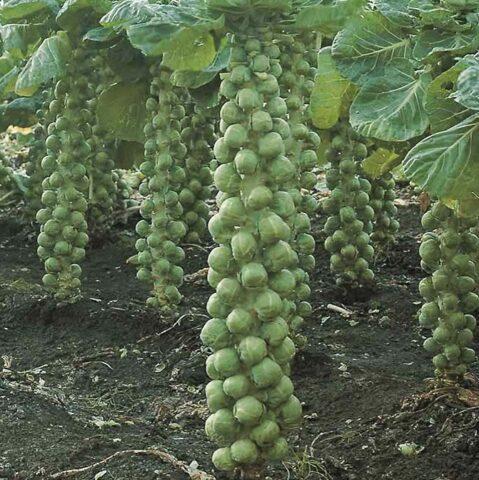
Unlike most hybrids, the Diablo F1 crop ripens gradually, the heads of cabbage are cut before the end of October, beginning of November
Mid-season cabbage varieties
Mid-season varieties are considered to be those that ripen in 120-140 days. They store better than early ones, however, when planting them in regions with a temperate or more severe climate, there is always a risk that the crop will not have time to ripen.
Funny company
Cheerful company - Brussels sprouts, created at the Sedek agricultural company. She has no special recommendations regarding growing regions.Included in the State Register in 2011.
Mature heads of cabbage are formed in 120-140 days. The height of the stem is within 65-75 cm, the rosette is spreading, the leaves are located almost horizontally.
The stem with heads of cabbage forms a kind of cone. They are elliptical, with a total number of about 60 pieces and weighing 0.6 kg per stem. Productivity per 1 m² – 2.5 kg. In size and color, Brussels sprouts of the Merry Company variety are similar to small red-violet plums. The taste is rated as "good".
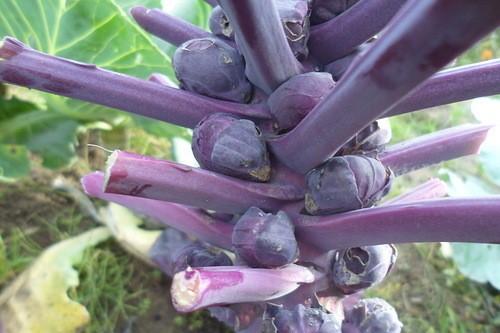
A cheerful company is great for decorating fresh vegetable salads
Brussels F1
Brussels sprouts hybrid Brussels F1 belongs to the category of mid-season or mid-late (135-145 days). Not yet listed in the State Register.
Brussels sprouts Brussels F1 have “innate” immunity to fusarium. It tolerates heat and low temperatures well, has good transportability and keeping quality. The most important agrotechnical activity is watering.
Plants are tall (1 m). The heads of cabbage seem not to be fully formed, but this “half-openness” is a feature of the variety. There are few of them on the plant (20-30 pieces), but they are large (about 25 g). The hybrid is valued for its external presentation and excellent taste. The total yield is 4-5 kg/m².
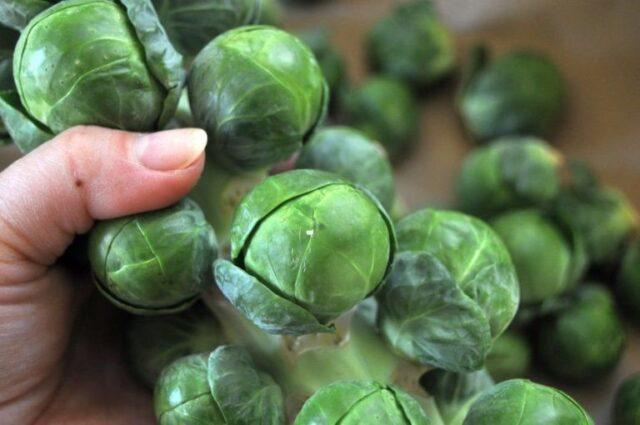
The heads of cabbage of the Brussels F1 hybrid are actively set, even if the weather during the season cannot be called favorable for gardening
Garnet bracelet F1
Pomegranate bracelet F1 is a domestic hybrid of Brussels sprouts from the Gavrish agricultural company. The variety was included in the State Register in 2011. It is suitable for planting in any region of the Russian Federation due to its general “stress resistance” and ease of care.
The harvest ripens in 120-125 days. Rosettes of purple-violet leaves are raised, relatively compact and not too tall.
The heads of cabbage form a very dense “column”.They are almost spherical, small (maximum 0.4-0.5 kg per stem). 30-40 pieces are removed from one plant, 1.5-2 kg from 1 m².
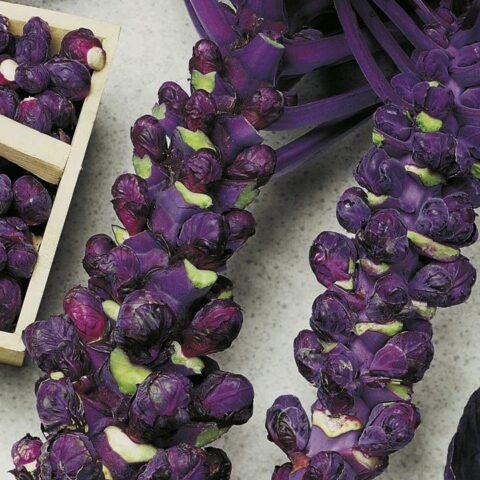
Hybrid Pomegranate bracelet F1 is valued by gardeners for its delicate taste, originality of appearance and dietary properties
Late ripening varieties of Brussels sprouts
Late varieties and hybrids of Brussels sprouts in many Russian regions can be grown exclusively indoors. It takes 140-180 days to ripen. But the process may take longer, depending on the weather during the season.
Sanda
Sanda is a relatively new variety and is not yet included in the State Register. Gardeners who have experience in growing it note consistently high yields, the “presentation” of the heads of cabbage, and their outstanding taste. Another undoubted advantage is the presence of innate immunity to mucous bacteriosis.
Heads of Brussels sprouts Sanda ripen in 135-140 days. In some regions this variety is classified as mid-late. The harvest ripens en masse, it is suitable for any culinary recipes, freezing, and home canning.
The stems grow up to 1 m in height. Heads of cabbage weighing 10-15 g, dense and juicy. The stem is practically “covered” with them, which raises the overall indicators to 2-2.5 kg/m².
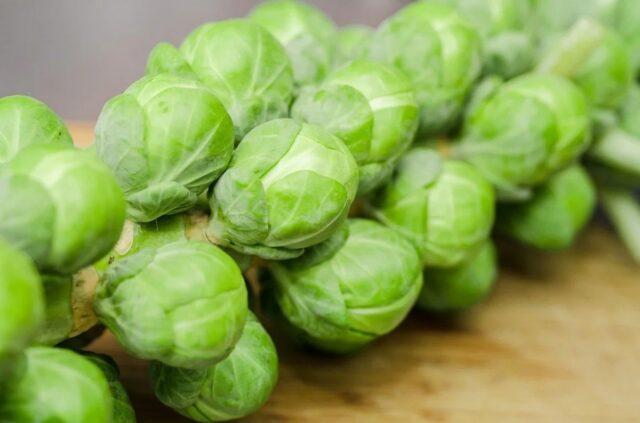
Sanda is distinguished by powerful branched roots
Bunch of grapes
Grape bunch is a variety of Brussels sprouts of Russian selection, not included in the State Register.It is valued mainly for its original appearance (the heads of cabbage resemble large purple-red grapes) and its outstanding, delicately piquant taste with clearly distinguishable nutty notes.
It takes 150-160 days to ripen. Heads of cabbage are cut off gradually. Their quality does not suffer when the temperature drops to -5 °C.
30-45 heads of cabbage weighing 15-20 g of regular spherical shape are formed on the stem. When fresh, they are stored for 4-5 months. The crop is also characterized by good transportability.
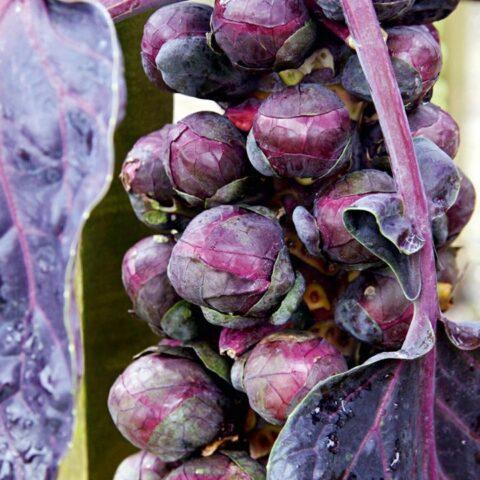
A bunch of grapes needs regular feeding, but even in this case it will not produce record high yields (maximum 1.5 kg/m²)
Diamond F1
Diamond F1 is a Dutch hybrid of Brussels sprouts created by Nickerson Zwaan B. V. It has been officially registered in Russia since 2013 and is allowed to land in all regions.
The harvest ripens in 140-150 days. The rosette is quite compact, semi-raised, with large leaves. The heads of cabbage are of an unusual obovate shape, bluish-green. The stem with them looks like a cone.
The hybrid is characterized as unpretentious in care, characterized by good immunity, and resistant to lodging. 30-60 heads of cabbage are formed on one stem, their weight varies between 7-20 g. The total yield is up to 3 kg/m².
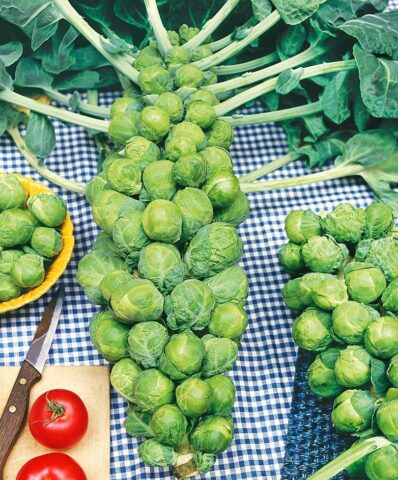
The rosette of leaves in the hybrid Brilliant F1 develops quite slowly even for late varieties, but this does not affect the yield
The best varieties of Brussels sprouts for the Moscow region
It is quite difficult to guess what the season will be like in the Moscow region. Both early frosts and long warm autumns are possible here. But it’s better not to take risks by planting only late-ripening varieties, but to select several early varieties of Brussels sprouts suitable for the middle zone.
Hercules
The only variety of Brussels sprouts created in the USSR.In the State Register since 1950, there are no restrictions regarding the regions of planting, the culinary purpose is universal.
The stems stretch 80-90 cm, the rosettes are powerful. Heads weighing 20-30 g, round. The harvest ripens in 115-130 days.
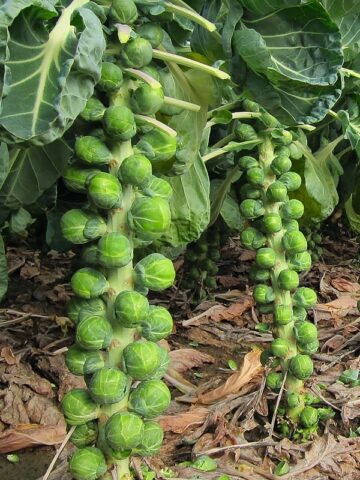
Hercules produces approximately the same yields when planted on “street” beds and in greenhouses.
Curl
The curl is an achievement of the famous Czech agricultural company Moravoseed. It came to Russia in the mid-90s of the 20th century and is not listed in the State Register. According to the ripening period – mid-season or mid-late.
The plant stretches 80-90 cm, remaining quite compact. Heads of cabbage weigh 10-15 g, not too dense, with a yellowish tint when cut. The taste is good, but not outstanding. Amateur gardeners remove an average of 2.5 kg/m².
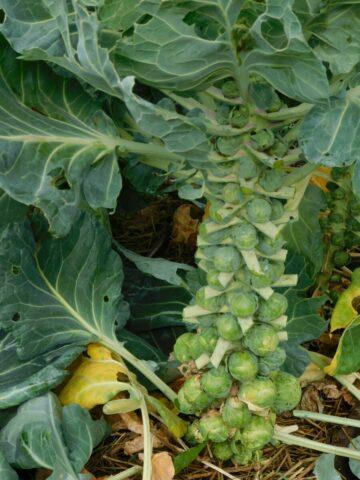
At the initial stage of head formation, Zavitka is very demanding on regular watering.
Boxer F1
The birthplace of the Boxer F1 hybrid is the Netherlands (Bejo Zaden B.V.), but in Russia you can also purchase domestic seeds produced under license by the Gavrish agricultural company. The variety is medium late (130-140 days), valued for its outstanding taste, external presentation, and general endurance.
The stems stretch up to 90-100 cm, 20-30 dense heads of cabbage are formed on each, the yield per plant is 0.4-0.5 kg (total - 1.6-1.8 kg/m²). Brussels sprouts of the Boxer variety ripen en masse, and after falling under the first frost, their taste only improves.
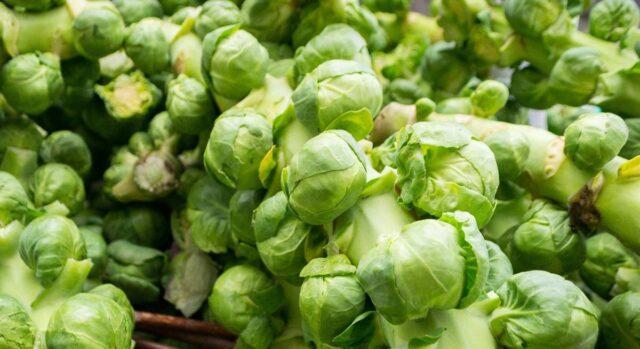
The Boxer hybrid is picky about the quality of the substrate in the garden - the soil must be fertile and loose
Brussels sprouts varieties for Siberia
Summer in Siberia is short and not hot, so early and mid-early varieties of Brussels sprouts are best suited for local gardeners. It is also cultivated indoors.
Long Island
Long Island is an old and still popular variety of Brussels sprouts, created in the USA in the 90s of the 19th century. Not included in the State Register. Drought and heat resistant, does not suffer from low temperatures during the summer, frosts down to -12 ° C.
Harvest ripening period is 85-105 days. The plants are compact, quite tall (80-100 cm), powerful. Heads of cabbage weighing 15-20 g, about 100 pieces are formed on one stem. When planted according to the standard scheme, 3-4 kg/m² is obtained.
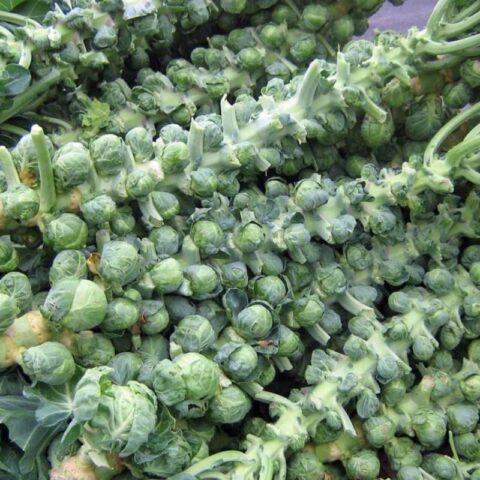
Long Island heads show good preservation on the stem
Rosella
Rosella is a variety of Brussels sprouts from Germany, created by the agricultural company Samen Mauser Quedlinburg GMBH. In the Russian State Register since 1995. The variety is from the mid-early category (110-120 days), the harvest ripens together.
The height of the stems greatly depends on the cultivation method (open or closed ground). The heads of cabbage are ovoid, quite dense, weighing 12-13 g. 30-45 of them are formed on the stem. The total yield reaches 1.5 kg/m².
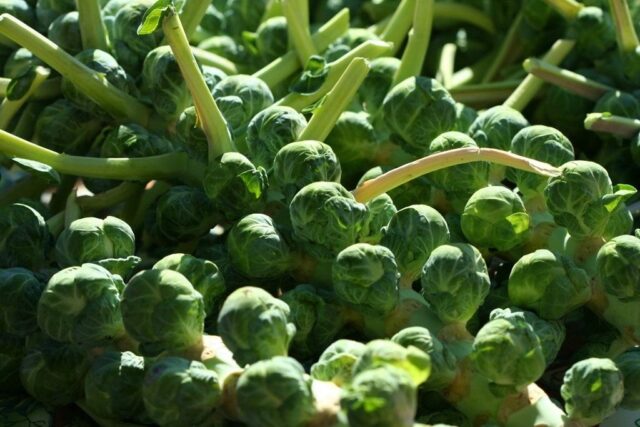
In the State Register, the taste of Rosella is characterized as “satisfactory”, but gardeners consider this assessment to be underestimated
Casio
The Brussels sprout variety Casio is the result of a “collaboration” between the Russian agricultural company Semko and the Czech Moravoseed. In the State Register since 1997, there are no restrictions on growing regions. Belongs to mid-season (125-135 days).
The stems are of medium height, the heads are dense, noticeably flattened, blue-green. The taste is original, with a nutty note. Average weight is 10-11 g, quantity per stem is 60-70 pieces. In open ground beds they get 1.8-2 kg/m².
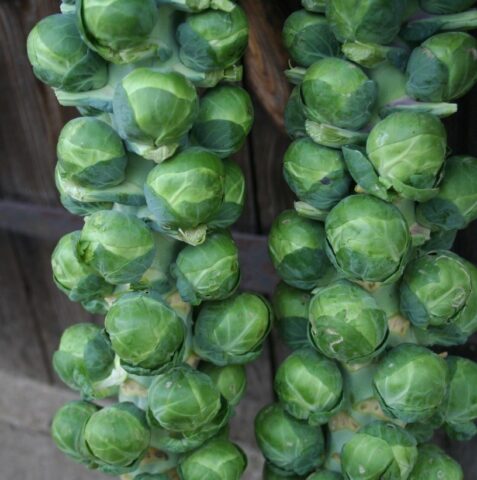
Casio tolerates low temperatures in summer well, but the first frosts are destructive for the crop
Brussels sprouts varieties for the Urals
The Ural climate is in many ways similar to the Siberian one. Therefore, local gardeners choose varieties and hybrids of any crops for cultivation (including Brussels sprouts) based on the same criteria.
Commander
Komandor is a mid-season (110-120 days) variety of Brussels sprouts from the Gavrish agricultural company. In the State Register since 2011. Suitable for any Russian region due to its general “stress resistance” endurance. Tolerates cold temperatures down to -7-10 °C.
The plant is quite compact, the rosette is semi-raised. The heads of cabbage are round and arranged “loosely” on the stem. 20-40 of them are formed on the plant, the total mass is in the range of 450-600 g. The cultivation method has practically no effect on the overall indicators (1.8 kg/m²).

Negative external influences have a slight effect on the yield volume of the Komandor variety
Black eyes F1
Hybrid Brussels sprouts Ochi black F1 is one of the new products of Russian selection. The variety is not yet listed in the State Register. The harvest ripens in 115-120 days.
The plants are low (60-70 cm), compact. The heads of cabbage are dense, round, bright purple, weighing 10-20 g, 30-40 pieces per stem (in total, taking into account the standard planting scheme -1.5-2.5 kg/m²).
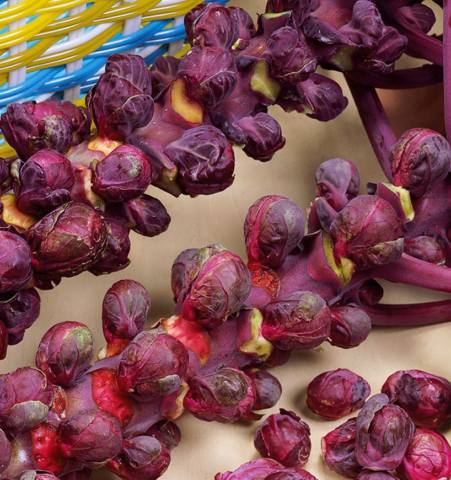
The rich color of the heads of the Ochi black F1 variety and the original bitter taste are preserved even after heat treatment.
Nuts F1
F1 nuts are another domestic hybrid of Brussels sprouts that has recently appeared on the market. Not included in the State Register. It takes 115-130 days for the crop to ripen.
The rosette of leaves is semi-raised, low (up to 60 cm). The heads of cabbage are dense and juicy, round, weighing 10-15 g. Up to 0.6 kg of Brussels sprouts of this variety are obtained from the stem.The first frosts down to -7 °C have a positive effect on its taste.
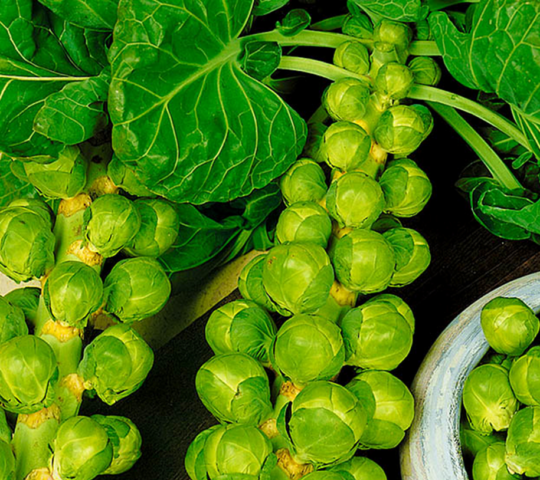
For better preservation, heads of the Oreshki F1 variety are recommended to be cut along with the stem
Conclusion
Hybrids and varieties of Brussels sprouts for growing on your own plot are chosen, first of all, taking into account the timing of their ripening. But this is not the only fundamentally important characteristic for a gardener. The description needs to be studied in full - this is the only way to roughly estimate the dimensions of the plants, understand what kind of harvest you should expect, how long it will be stored, and how best to use it.
